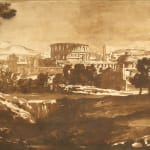 Jan de Bisschop - Mountainous Jan de Bisschop - Landscape in Italy (RP-T- 1898-A-3528. 118 x 209 mm) - Rijksmuseum - Amsterdam - Netherlands
Jan de Bisschop - Mountainous Jan de Bisschop - Landscape in Italy (RP-T- 1898-A-3528. 118 x 209 mm) - Rijksmuseum - Amsterdam - Netherlands
 Jan de Bisschop - Colosseum at Rome with buildings (RP-T-1909-39. 124 x 208 mm) - Rijksmuseum - Amsterdam - Netherlands
Jan de Bisschop - Colosseum at Rome with buildings (RP-T-1909-39. 124 x 208 mm) - Rijksmuseum - Amsterdam - Netherlands
Jan de Bisschop
20 x 32 cm
Plus d'images
Despite his amateur status, Jan de Bisschop (also known as Johannes Episcopius) was widely influential in art and art publishing. A lawyer by profession, he set up practice in The Hague around 1652 and later founded a drawing academy there. He mingled with an elite circle of intellectuals that included his friend and fellow amateur draftsman Constantijn Huygens the Younger.
Bartholomeus Breenbergh, who lived in de Bisschop's native Amsterdam for a time, most influenced de Bisschop's draftsmanship. De Bisschop's landscapes in brown ink wash imitated Breenbergh's evocations of Italianate sunlight. Despite drawing numerous Italianate landscapes, de Bisschop probably never went to Italy; other artists' works were his sources. Whether drawing with pen or brush, de Bisschop used a warm golden-brown ink, later named "bisschops-inkt" after him. De Bisschop in his turn had a great influence on his friend Jacob van der Ulft.
In addition to landscapes, de Bisschop made figure studies and drawings after classical sculptures and famous paintings, primarily by Italian artists. His publications, which reproduced antique sculptures and Old Master drawings, were instrumental in disseminating the classical style in Holland. He also designed title pages for books, mostly by classical authors, and published his own compositions.
Two related drawings in the Rijksmuseum in Amsterdam illustrate his very specific technique (and his taste for oblong format) of which we find a perfect example in our drawing: Mountainous Landscape in Italy (RP-T- 1898-A-3528. 118 x 209 mm) and Colosseum at Rome with buildings (RP-T-1909-39. 124 x 208 mm).
It is to be noted that the upper part of our drawing (including the large tree on the left) is on a different sheet which has been pasted with the lower part’s one. This technique was widely used in the 17th century at a time when paper was costly to hide a mistake or allow some reworking while keeping the largest part of a drawing.










